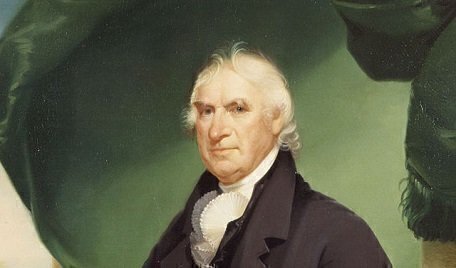On this day in 1787, the debate over the newly written Constitution began in the press after an anonymous writer in the New York Journal warned citizens that the document was not all that it seemed.
 “This form of government is handed to you by the recommendations of a man who merits the confidence of the public; but you ought to recollect, that the wisest and best of men may err, and their errors, if adopted, may be fatal to the community,” said the author who took the pen name “Cato” to voice his displeasure with parts of a Constitution championed by George Washington, James Madison and Benjamin Franklin. (The identify of Cato was reportedly then-New York Governor George Clinton, pictured here.)
“This form of government is handed to you by the recommendations of a man who merits the confidence of the public; but you ought to recollect, that the wisest and best of men may err, and their errors, if adopted, may be fatal to the community,” said the author who took the pen name “Cato” to voice his displeasure with parts of a Constitution championed by George Washington, James Madison and Benjamin Franklin. (The identify of Cato was reportedly then-New York Governor George Clinton, pictured here.)
Most Americans know of the Federalist Papers, the collection of essays written by Alexander Hamilton, John Jay, and Madison, in defense of the U.S. Constitution. Fewer know of the Anti-Federalist Papers authored by Cato and other incognito writers, their significance to American political history, or their responsibility for producing the Bill of Rights.
When the Constitution was drafted in the summer of 1787, its ratification was far from certain; it still needed to be ratified by at least nine of the 13 state legislatures. The failure of the Articles of Confederation made it clear that America needed a new form of government. Yet there was worry that the Constitution gave too much power to the federal government. The original draft of the Constitution did not have a Bill of Rights, declared all state laws subservient to federal ones, and created a king-like office in the presidency. At the Philadelphia Convention and in the Federalist Papers, James Madison argued against having a Bill of Rights, fearing that they would limit the people’s rights.
Opposition to the Constitution after the Philadelphia Convention began with Elbridge Gerry, Edmund Randolph, and George Mason, the “Three Dissenters” who refused to sign the document. It then grew to include Patrick Henry, Samuel Adams, and Richard Henry Lee, heroes of the Revolutionary War who objected to the Constitution’s consolidation of power. In time, the various opponents to the new Constitution came to be known as the Anti-Federalists. Their collected speeches, essays, and pamphlets later became known as the “Anti-Federalist Papers.”
While each of the Anti-Federalists had their own view for what a new constitution for the United States should look like, they generally agreed on a few things. First, they believed that the new Constitution consolidated too much power in the hands of Congress, at the expense of states. Second, they believed that the unitary president eerily resembled a monarch and that that resemblance would eventually produce courts of intrigue in the nation’s capital. Third, they believed that the liberties of the people were best protected when power resided in state governments, as opposed to a federal one. Lastly, they believed that without a Bill of Rights, the federal government would become tyrannous.
These arguments created a powerful current against adopting the Constitution in each of the states. In state legislatures across the country, opponents of the Constitution railed against the extensive powers it granted the federal government and its detraction from the republican governments of antiquity. In Virginia, Patrick Henry, author of the famous “Give Me Liberty or Give Me Death” speech, called the proposed constitution, “A revolution as radical as that which separated us from Great Britain.” In the Essays of Brutus, an anonymous author worried that without any limitations, the proposed Constitution would make “the state governments… dependent on the will of the general government for their existence.”
The Anti-Federalists mobilized against the Constitution in state legislatures across the country.
Anti-Federalists in Massachusetts, Virginia and New York, three crucial states, made ratification of the Constitution contingent on a Bill of Rights. In Massachusetts, arguments between the Federalists and Anti-Federalists erupted in a physical brawl between Elbridge Gerry and Francis Dana. Sensing that Anti-Federalist sentiment would sink ratification efforts, James Madison reluctantly agreed to draft a list of rights that the new federal government could not encroach.
The Bill of Rights is a list of 10 constitutional amendments that secure the basic rights and privileges of American citizens. They were fashioned after the English Bill of Rights and George Mason’s Virginia Declaration of Rights. They include the right to free speech, the right to a speedy trial, the right to due process under the law, and protections against cruel and unusual punishments. To accommodate Anti-Federalist concerns of excessive federal power, the Bill of Rights also reserves any power that is not given to the federal government to the states and to the people.
Since its adoption, the Bill of Rights has become the most important part of the Constitution for most Americans. In Supreme Court cases, the Amendments are debated more frequently than the Articles. They have been cited to protect the free speech of Civil Rights activists, protect Americans from unlawful government surveillance, and grant citizens Miranda rights during arrest. It is impossible to know what our republic would look like today without the persistence of the Anti-Federalists over two hundred years ago.
Ugonna Eze is a Fellow for Constitutional Studies at the National Constitution Center.







